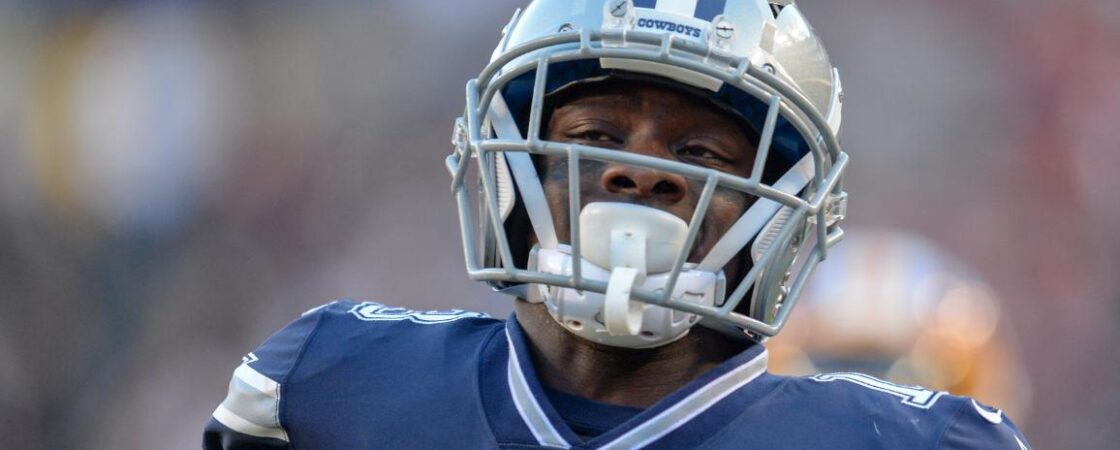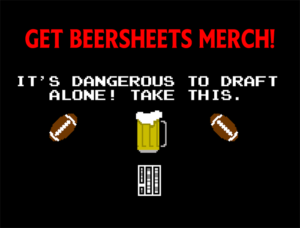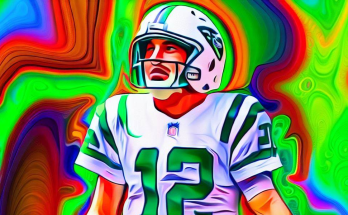WR3s are an interesting bunch to investigate. Since fantasy football is a weekly game, the WR3s generally fade in-and-out of usefulness as the season goes along, with guys fitting “just okay” games in between “pretty good” games, with touchdowns making the difference. They aren’t the guys you want to have in your WR3 slot if we are being honest. How do we evaluate these guys, and should we be drafting WR3s at their draft price? In short: what makes for a #3 wide receiver in fantasy football?
First, let’s talk terms. I looked at end-of-season rankings in a half-PPR (PPR) points per game basis (HPPR and PPG in order to weed out guys who hung around for 16 games at WR40 but ended up inside the top-36 because other WRs played 13 or 14 games). I wanted wide receivers who had useful fantasy football weeks when they played. That led me to the following list:
WR25 Diontae Johnson
WR26 Curtis Samuel
WR27 Tee Higgins
WR28 Robby Anderson
WR29 Corey Davis
WR30 Chris Godwin
WR31 Marquise Brown
WR32 Brandon Aiyuk
WR33 Cole Beasley
WR34 Cooper Kupp
WR35 Michael Gallup
WR36 Tyler Boyd
Quite an interesting list, here. There’s a mix of busts, breakouts, rookies, and post-hype sleepers. Notoriously absent from most of the list: WR3s who hit their ADP.
Only three came close to their draft expenditure, with Marquise Brown, Michael Gallup, and Tyler Boyd all going between WR29 and WR32 and finishing WR31, WR35, and WR36. What of their peers by average draft position? Let’s take a quick look at the other WR3s drafted (WR25 through 36). DeVante Parker, T.Y. Hilton, A.J. Green, Julian Edelman (injury), and Deebo Samuel (injury) all busted. Stefon Diggs took a big step forward, as did Will Fuller (though I have questions about his new-found durability). Jarvis Landry hit value, and Marvin Jones did Marvin Jones things: returning ridiculous value because people under draft him every year.
You can see that WR3 on draft day is a hodgepodge of names we hope can bounce back (Hilton, Green, Edelman), guys we aren’t quite sold on yet (Parker, Deebo, Fuller, Marquise Brown), guys who we think will be WR3s (Marvin Jones, Landry), and guys who had been good but whose situation had changed (Gallup, Boyd, Diggs). Let’s use these players as buckets to figure out what type of player we attack in the WR3 range in fantasy football drafts.
Immediately, you can cast aside bounce back wide receivers. Aging veterans who we hope can squeeze another year out of their usefulness. Hilton had some boom weeks, but they weren’t until late in the year, and if you took him as your third wide receiver, you weren’t happy. We had two separate funerals with regards to A.J. Green’s value this year, and Julian Edelman fell apart entirely. That’s the risk of the bounce back aging WR3: they keep aging. Go ahead and disregard them for your WR3 slot. The guys in this bucket finished, on average, as WR51. Not helpful.
What about the guys we aren’t quite sold on yet? DeVante Parker hamstrung lineups (pun intended) as the face of “the guy who hangs around with just enough value that you can’t bench him, but you’re never happy.” He did not finish as a WR1 once and finished as a WR2 or WR3 43% of the time. The other 57%? WR3 or worse. A total bust. Deebo Samuel at least had the good taste to play in only seven games, though he busted in five of them. Will Fuller cast aside his demons to take the league by storm, only to have us all find out that he probably chemically cast them aside, throwing doubt on his entire recovery.
Tyler Boyd and Michael Gallup both had their value kneecapped by rookies changing their whole situation (Tee Higgins and CeeDee Lamb, respectively). Taking them as WR3s was a tacit hope that the rookies wouldn’t take over too much… and they did. Still, Boyd returned plenty of useful weeks (top-36 57% of the time). Gallup, unfortunately, was a mirage (75% of games outside the top-36, with one top-five effort boosting him).
Marquise Brown had some buzz as a WR3 headed into the season and came out on the other side returning value. Though he had a strong beginning and end to 2020, he bottomed out in the middle of the season. That’s the anatomy of a lot of guys who end up in the WR3 ranks, but we will get to that in a second. First, let’s look at the success stories from guys drafted as WR3s: Marvin Jones and Stefon Diggs.
Marvin Jones went as a WR3 and ended the year as the WR16. We couldn’t have predicted Marvin Jones would have to deal with getting the targets from an injured Kenny Golladay… except Kenny Golladay was already injured headed into the season. Marvin Jones makes the case for taking a WR3 who you think will be a WR3, and everything else is gravy. This is where he sits every year, and every year this is what he does. His average draft price is WR34. His average finish is WR31.
Marvin Jones finished as WR17 this year but did that on the back of a handful of great games. But WR17 isn’t the story we tell ourselves when we take Marvin Jones. The story we tell ourselves is that he is a steady backend WR3 with WR2 upside. But why are we drafting Marvin Jones at his ADP when six-of-twelve WR3s went WR40 or later, and five of them went WR56 or later. Spending on Marvin Jones was overpaying for a floor when plenty of floor players exist later in the draft. There’s also the downside of this strategy, which Jarvis Landry personifies: he should finish as a WR3 or better, but he has limited upside and ends up busting out.
Don’t draft a WR3 for WR3 numbers.
Draft a WR3 because you see that the market has lost its mind and decided something to be true with no evidence. That’s what happened with Stefon Diggs. Diggs went as a WR3 but ended up as the WR3. You can take hits from Deebo or DeVante Parker if you end up with a Stefon Diggs as a part of your process. To me, Diggs felt like a slam dunk top-ten. Why? We constantly ranked Adam Thielen and Stefon Diggs at the WR1/WR2 split (around WR12 to WR13). You would always see the rationale that one of them would do great things if separated from the other.
Unfortunately, target volume would cannibalize the other. Well, they separated and somehow this dropped Diggs down in the ranks. An eminently talented wide receiver going off to a pass-happy team to be the undisputed WR1. And somehow, he went down in the ranks? His volume was about to go through the roof, and somehow, he went down.
That tells us where we find WR3s, the wide receivers who end up finishing with just enough useful games for us to pat them on their heads and tell them that they worked out well for us this year. It’s easy: volume.
Volume with a high amount of talent leads to WR2 and WR1 players. But what about wide receivers who get a lot of volume but only have marginal talent. The six wide receivers who went as WR40 or later who ended up inside the top-36 all did so by cashing in volume. We knew Diontae Johnson (WR25) would break out due to target volume, dropsies be damned. This also worked out for Cole Beasley (WR33), who now has back-to-back 100 target seasons in Buffalo.
I wrote about Robby Anderson and Curtis Samuel as receivers who would end up beating their draft price because unfulfilled air yards drove down their draft day price. But air yards mean volume, and cashing in that volume means production. They finished as WR28 and WR26, respectively, after going as WR56 and WR62 off the board.
Corey Davis (WR29, WR71 off the board) also showed that volume is king to non-superstar talented players pushing value. He had six games with five or fewer targets, and he totaled 140 yards and a touchdown in those four games. In his other games, he averaged 94 yards per game. The line between useful and useless comes down to volume.
Then, we get down to the rookies. Tee Higgins and Brandon Aiyuk went as WR72 and WR73 off the board, and finished as WR27 and WR32, respectively. These guys both hit the Corey Davis mold of flourishing with volume. For Tee Higgins in 2021, that volume will likely grow. I fear Brandon Aiyuk’s volume takes a hit in 2021 with the return of George Kittle and Deebo Samuel.
By looking at WR3s both in the predraft process and after the season, we learn several things. First, don’t draft #3 wide receivers to be #3 wide receivers. Take a shot on guys with upside who will end up outside the top-36. It isn’t worth taking a player with the idea of a safe floor. Second, half of the WR3s were drafted as WR40 or later, and success followed volume. That’s how you build a WR3 on the cheap.
Finally, we learn how to draft for this particular spot. Take a few guys who should take a step forward in volume and jam them onto your roster. If you took that approach in 2020, you ended up with Stefon Diggs or pre-suspension Will Fuller instead of A.J. Green or T.Y. Hilton. For 2021, that means taking Jerry Jeudy, Chase Claypool, or Darnell Mooney late instead of Jarvis Landry or DeVante Parker early.
If this has you hankerin’ for some fantasy sports, try out Fan Duel! That link lets them know we sent you! It also gets you a 20% deposit match up to $500!
Then, follow Football Absurdity on Twitter!
After that, get free fantasy football advice by joining our Discord!
Finally, if you like what you read here, check out our podcast and our Patreon




One Comment on “Fantasy Football: The Anatomy of a #3 Wide Receiver”